Assessment of Carbon Storage under Different SSP-RCP Scenarios in Terrestrial Ecosystems of Jilin Province, China
Abstract
:1. Introduction
2. Materials and Methods
2.1. Study Area
2.2. Data Source and Processing
2.3. Method of Study
2.3.1. PLUS Model
- (1)
- SSP1-RCP2.6 scenario: This scenario can be understood as a sustainable development scenario, which strictly limits the transfer out of ecological land such as forest land and grassland by setting constraints, i.e., strengthening the protection of ecological lands. At the same time, relevant policies and plans are considered, and a cost transfer matrix with ecological protection as the priority is set without affecting the urbanization process, i.e., without reducing the expansion capacity of built-up areas and other lands. This scenario shows a trend of population increase and then decrease from the beginning of the 21st century to 2100, and a clear trend of GDP increase. Forest land is protected under this scenario and the type of economic development is dominated by forestry.
- (2)
- SSP2-RCP4.5 scenario: This scenario represents an intermediate path with moderate radiative forcing, which is a continuation of the current land use change trend. The land demand in the LUH2 dataset is extracted to obtain the number and area of each category of raster in Jilin Province in 2030 and 2040 under this scenario. The future land use changes in Jilin Province are simulated without setting any constraints under this scenario. The trend of population and GDP change in this scenario is the same as in SSP1, but the difference is that the turning point of population change occurs in 2030. The type of economic activity shows a trend in the synergistic development of various industries such as agriculture, pastoralism, and forestry.
- (3)
- SSP5-RCP8.5 scenario: Different from the above scenario, this scenario prioritizes economic development. High economic development is achieved through the continuous development of fossil fuels. Meanwhile, SSP585 is the scenario with the highest greenhouse gas (GHG) emissions. The high-emission development strategy leads to substantial changes in various land categories. The turning point of population change in this scenario occurs in 2025, and the trend of change is basically the same as in SSP1. The type of economic activity is dominated by industry.
2.3.2. InVEST Model
3. Results and Analysis
3.1. Land Use Dynamics and Multi-Scenario Predictions
3.2. Carbon Storage Change Characteristics in 2000–2040
3.3. Impact Factors of Carbon Storage Changes
4. Discussion and Conclusions
4.1. Discussion
4.2. Conclusions
Author Contributions
Funding
Institutional Review Board Statement
Informed Consent Statement
Data Availability Statement
Acknowledgments
Conflicts of Interest
References
- Zhang, Y.; Shi, X.; Tang, Q. Carbon storage assessment in the upper reaches of the Fenhe River under different land use scenarios. Acta Ecol. Sin. 2021, 41, 360–373. (In Chinese) [Google Scholar]
- Zhang, P.; Li, Y.; Yin, H.; Chen, Q.; Dong, Q.; Zhu, L. Spatial-temporal variation and dynamic simulation of ecosystem carbon storage in the north-south transitional zone of China. J. Nat. Resour. 2022, 37, 1183–1197. (In Chinese) [Google Scholar]
- Liu, X.; Wang, S.; Wu, P.; Feng, K.; Hubacek, K.; Li, X.; Sun, L. Impacts of urban expansion on terrestrial carbon storage in China. Environ. Sci. Technol. 2019, 53, 6834–6844. [Google Scholar] [CrossRef] [PubMed]
- Zhang, K.; Chen, J.; Hou, J.; Zhou, G.; You, H.; Han, X. Study on sustainable development of carbon storage in Guilin coupled with InVEST and GeoSOS-FLUS model. China Environ. Sci. 2022, 42, 2799–2809. (In Chinese) [Google Scholar]
- Zhu, W.; Zhang, J.; Cui, Y.; Zhu, L. Ecosystem carbon storage under different scenarios of land use change in Qihe catchment, China. J. Geogr. Sci. 2019, 30, 1507–1522. [Google Scholar] [CrossRef]
- Liu, X.; Li, X.; Liang, X.; Shi, H.; Ou, J. Simulating the change of terrestrial carbon storage in China based on the FLUS-InVEST model. Trop. Geogr. 2019, 39, 397–409. (In Chinese) [Google Scholar]
- Meng, X.; Yu, L.; Zhou, Y.; Li, S. Predicting organic carbon using data fusion of visible near-infrared and middle infrared spectra by proximal soil sensing. Chin. J. Soil Sci. 2022, 53, 301–307. (In Chinese) [Google Scholar]
- Zhang, Y.; Huang, Q.; Ma, R.; Chen, W. Retrieving of dissolved organic carbon based on irradiance reflectance in typical lake zones of lake Taihu. Adv. Earth Sci. 2005, 20, 772–777. (In Chinese) [Google Scholar]
- Huang, S.; Xu, H.; Lin, N.; Zeng, H.; Liu, Z.; Chen, W.; Wang, L.; Yang, R. Remote-sensing estimate of the carbon storage of subtropical Pinus Massoniana forest in the Hetian Basin of County Changting, China. Acta Ecol. Sin. 2013, 33, 2992–3001. (In Chinese) [Google Scholar] [CrossRef]
- Ba, X.; Sui, X.; Bao, X.; An, H.; Xie, H.; Liu, M. Impacts of intercropping with cover crops and maize on soil carbon and nitrogen contents and related enzyme activities. Chin. J. Soil Sci. 2022, 53, 577–587. (In Chinese) [Google Scholar]
- Liang, C.; An, J.; Fan, X.; Liang, J.; Zhang, X. Surface soil carbon density and turnover rate of typical vegetation types in Beijing Songshan National Nature Reserve. Earth Environ. 2020, 48, 672–679. (In Chinese) [Google Scholar]
- Cheng, X.; Zhao, G.; Song, Y.; Chen, N.; Zhang, Z.; Gao, S.; Liu, Z.; Du, Y. Carbon and nitrogen contents and enzyme activities of soil in peatland of permafrost region in greater Hinggan mountains under exogenous nitrogen input. Wetl. Sci. 2022, 20, 196–204. (In Chinese) [Google Scholar]
- Yang, J.; Xie, B.; Zhang, D. Spatio-temporal evolution of carbon storage in the Yellow River Basin based on InVEST and CA-Markov models. Chin. J. Eco-Agric. 2021, 29, 1018–1029. (In Chinese) [Google Scholar]
- Deng, Y.; Yao, S.; Hou, M.; Zhang, T.; Lu, Y.; Gong, Z.; Wang, Y. Assessing the effects of the Green for Grain Program on ecosystem carbon storage service by linking the InVEST and FLUS models: A case study of Zichang county in hilly and gully region of Loess Plateau. J. Nat. Resour. 2020, 35, 826–844. (In Chinese) [Google Scholar]
- He, X.; Xu, Y.; Fan, X.; Geng, Q.; Tian, Z. Temporal and spatial variation and prediction of regional carbon storage in Zhongyuan Urban Agglomeration. China Environ. Sci. 2022, 42, 2965–2976. (In Chinese) [Google Scholar]
- Zhu, G.; Qiu, D.; Zhang, Z.; Sang, L.; Liu, Y.; Wang, L.; Wan, Q. Land-use changes lead to a decrease in carbon storage in arid region, China. Ecol. Indic. 2021, 127, 107770. [Google Scholar] [CrossRef]
- Li, J.P.; Xia, S.X.; Yu, X.B.; Li, S.X.; Xu, C.; Zhao, N.; Wang, S.T. Evaluation of carbon storage on terrestrial ecosystem in Hebei province based on InVEST model. J. Ecol. Rural Environ. 2020, 36, 854–861. (In Chinese) [Google Scholar]
- Wu, P.; Liu, X.; Li, X.; Chen, Y. Impact of urban expansion on carbon storage in terrestrial ecosystem based on InVEST model and CA: A case study of guangdong province, China. Geogr. Geo-Inf. Sci. 2016, 32, 22–36. (In Chinese) [Google Scholar]
- Garnett, M.; Ineson, P.; Stevenson, A.; Howard, D. Terrestrial organic carbon storage in a British moorland. Glob. Chang. Biol. 2001, 7, 375–388. [Google Scholar] [CrossRef] [Green Version]
- Jian, N. Carbon storage in Chinese terrestrial ecosystem: Approaching a more accurate estimate. Clim. Chang. 2013, 119, 905–917. [Google Scholar]
- Ke, X.; Tang, L. Impact of cascading processes of urban expansion and cropland reclamation on the ecosystem of a carbon storage service in Hubei Province, China. Acta Ecol. Sin. 2019, 39, 672–683. (In Chinese) [Google Scholar]
- Jian, K.; Wang, S.; Guo, L.; Zhang, Q. Spatial distribution simulation and trend analysis of land use in Sanya based on GeoSOS-FLUS model. Urban Reg. Plan. 2020, 5, 97–108. [Google Scholar]
- IPCC. Special Report on Global Warming of 1.5 °C; Cambridge University Press: Cambridge, UK, 2018. [Google Scholar]
- Riahi, K.; Van Vuuren, D.P.; Kriegler, E.; Edmonds, J.; O’neill, B.C.; Fujimori, S.; Tavoni, M. The shared socioeconomic pathways and their energy, land use, and greenhouse gas emissions implications: An overview. Glob. Environ. Chang. 2017, 42, 153–168. [Google Scholar] [CrossRef] [Green Version]
- Wang, L. Study on the Spatial-Temporal Evolution and Its Efficiency of Land Use Carbon Emissions in Jilin Province; Jilin University: Jilin, China, 2021; pp. 12–13. (In Chinese) [Google Scholar]
- Wang, Z.; Zhang, B.; Zhang, S. Study on the effects of land use change on ecosystem service values of Jilin Province. J. Nat. Resour. 2004, 19, 55–61. (In Chinese) [Google Scholar]
- Xi, X.; Zhang, J.; Liao, Q.; Chen, D.; Bai, R.; Huang, Z. Multi-purpose regional geochemical survey and soil carbon reserves problem: Examples of Jiangsu, Henan, Sichuan, Jilin province and inner Mongolia. Quat. Sci. 2008, 1, 58–67. (In Chinese) [Google Scholar]
- Xu, L.; He, N.; Yu, G. A dataset of carbon density in Chinese terrestrial ecosystem (2010s). China Sci. Data 2019, 4, 90–96. (In Chinese) [Google Scholar]
- Liang, X.; Guan, Q.; Clarke, K.; Liu, S.; Wang, B.; Yao, Y. Understanding the drivers of sustainable land expansion using a patch-generating land use simulation (PLUS) model: A case study in Wuhan, China. Comput. Environ. Urban Syst. 2021, 85, 101569. [Google Scholar] [CrossRef]
- Sun, J.; Zhang, Y.; Qin, W.; Chai, G. Estimation and Simulation of Forest Carbon Stock in Northeast China Forestry Based on Future Climate Change and LUCC. Remote Sens. 2022, 14, 3653. [Google Scholar] [CrossRef]
- Gao, L.; Tao, F.; Liu, R.; Wang, Z.; Leng, H.; Zhou, T. Multi-scenario simulation and ecological risk analysis of land use based on the PLUS model: A case study of Nanjing. Sustain. Cities Soc. 2022, 85, 104055. [Google Scholar] [CrossRef]
- Lin, Z.; Peng, S. Comparison of multimodel simulations of land use and land cover change considering integrated constraints-A case study of the Fuxian Lake basin. Ecol. Indic. 2022, 142, 109254. [Google Scholar] [CrossRef]
- Wang, K.; Li, X.; Lyu, X.; Dang, D.; Dou, H.; Li, M.; Cao, W. Optimizing the Land Use and Land Cover Pattern to Increase Its Contribution to Carbon Neutrality. Remote Sens. 2022, 14, 4751. [Google Scholar] [CrossRef]
- Han, J. The Impact of Urban Sprawl on Carbon Storage Based on the InVEST Model; Northeast Normal University: Changchun, China, 2013; pp. 33–34. (In Chinese) [Google Scholar]
- Alam, S.; Starr, M.; Clark, B. Tree biomass and soil organic carbon densities across the Sudanese woodland savannah: A regional carbon sequestration study. J. Arid Environ. 2013, 89, 67–76. [Google Scholar] [CrossRef]
- Giardina, C.; Ryan, M. Evidence that decomposition rates of organic carbon in mineral soil do not vary with temperature. Nature 2000, 404, 858–861. [Google Scholar] [CrossRef] [PubMed]
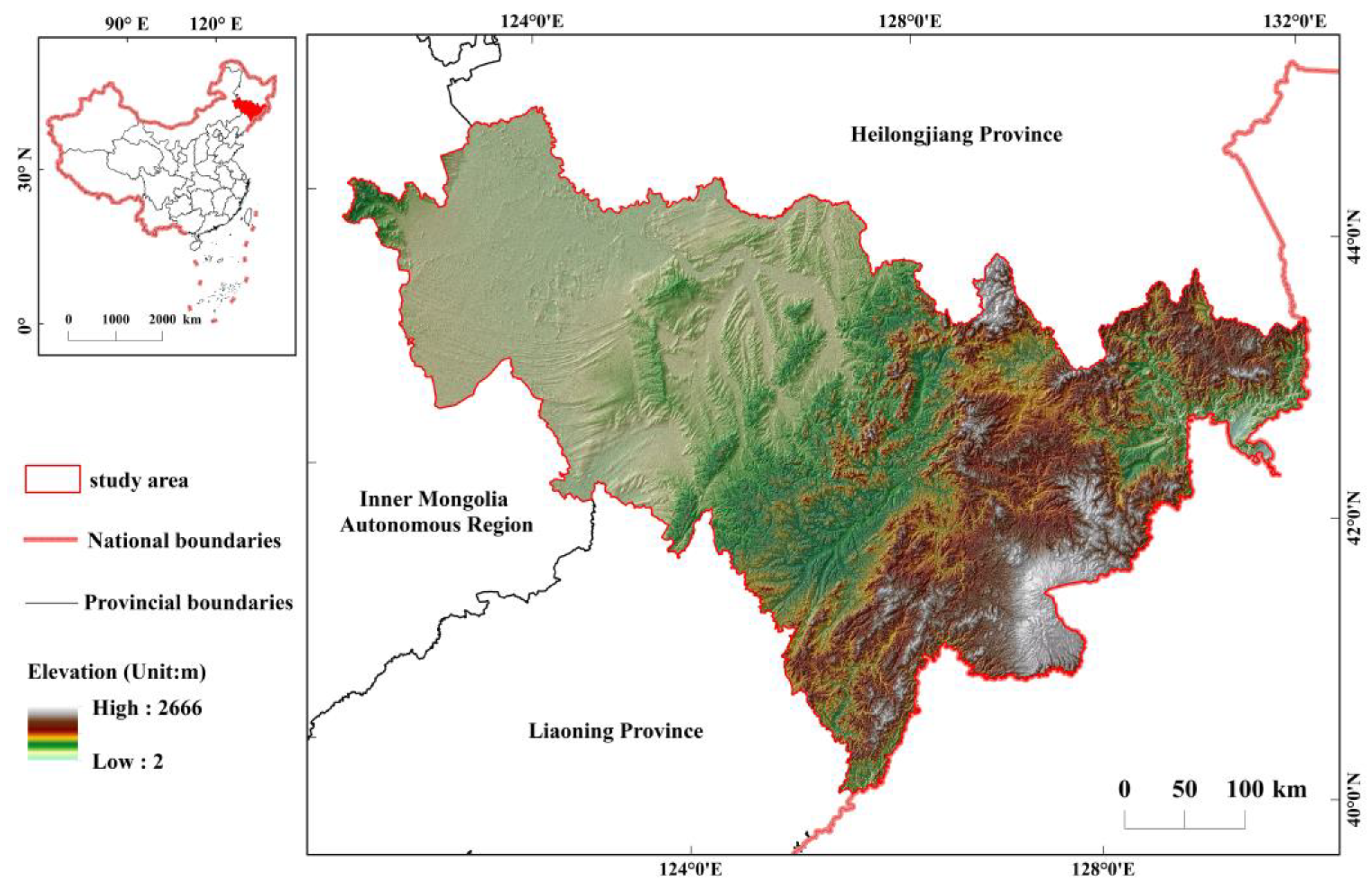
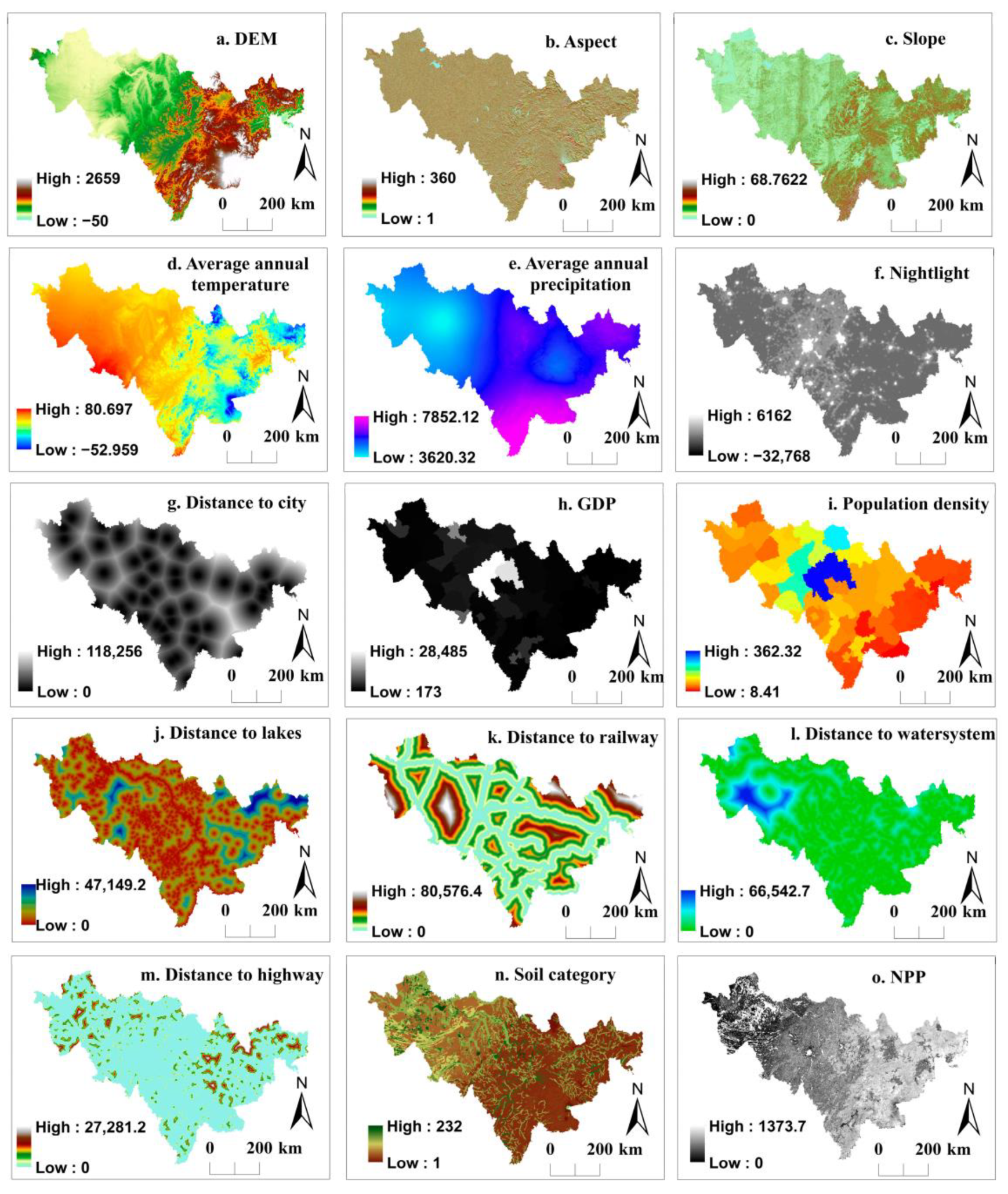
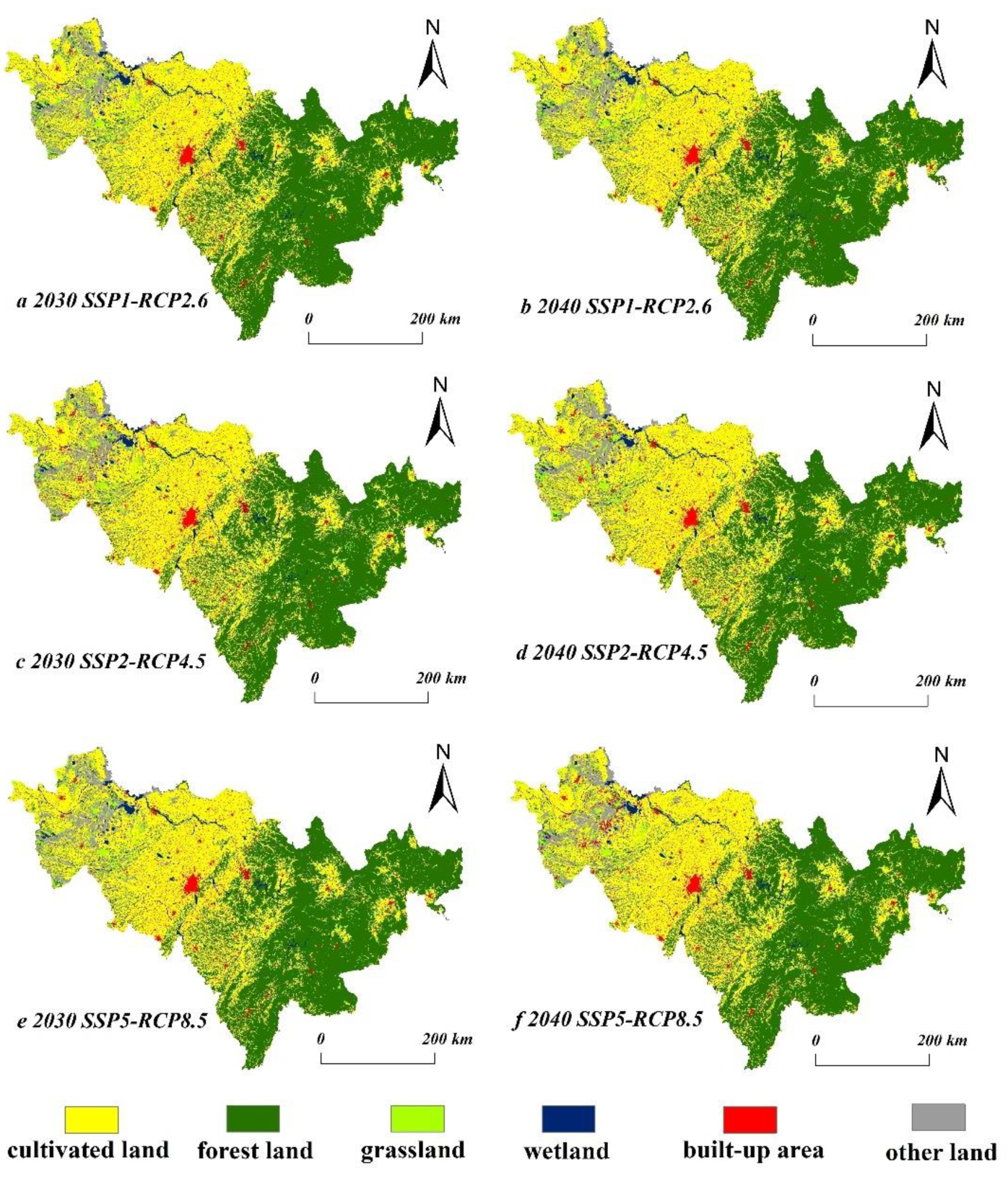
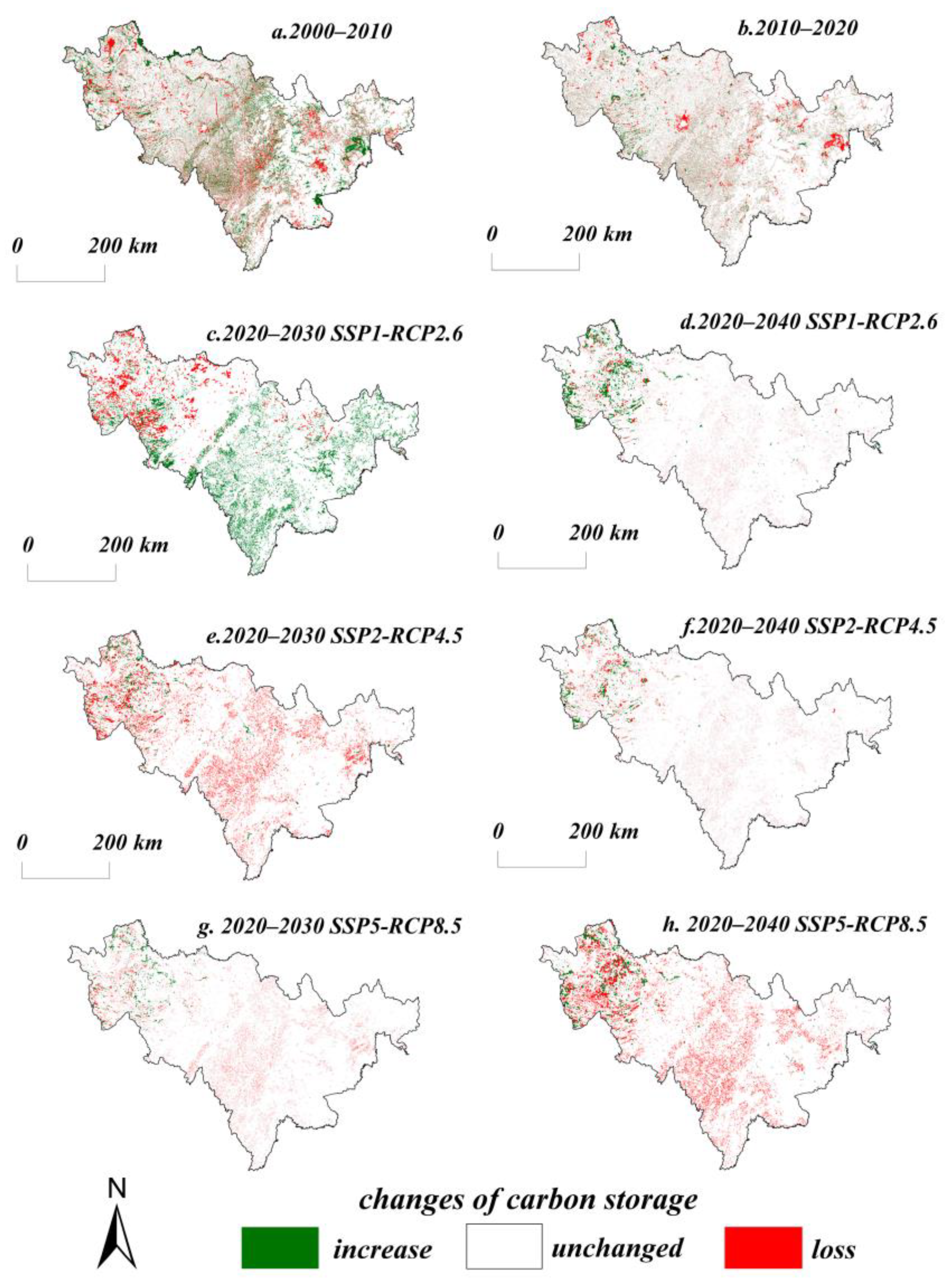

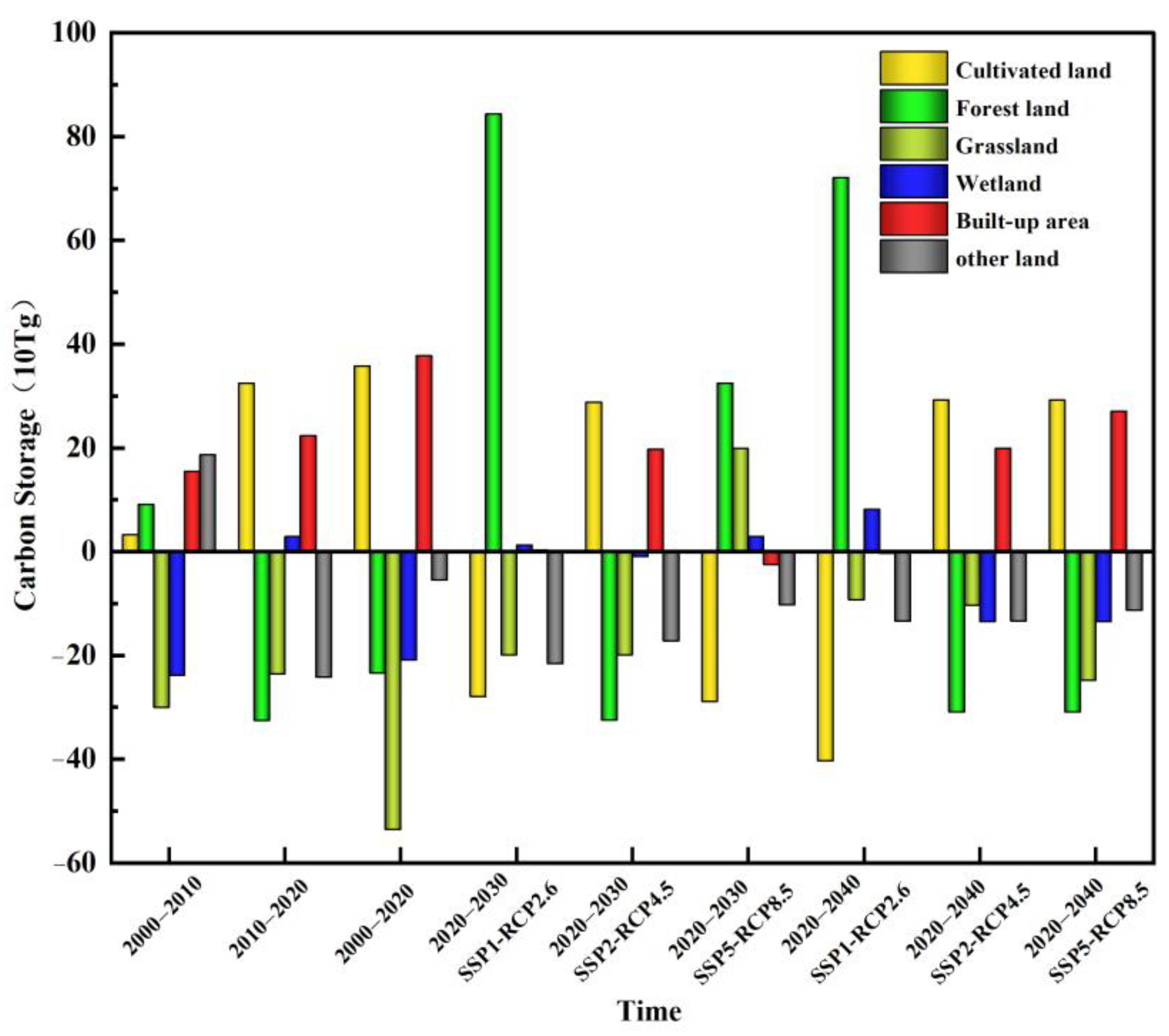
| Data Type | Content of Data | Data Sources |
|---|---|---|
| Data of Land Use | Land use data of Jilin Province in 2000, 2010, and 2020 LUH2 dataset | United States Geological Survey (USGS) (http://earthexplorer.usgs.gov/) accessed on 6 May 2021 Land-Use Harmonization (https://luh.umd.edu/) accessed on 11 May 2021 |
| Data of Driving Factor | Average annual temperature, average annual precipitation | National Meteorological Science Data Center (http://data.cma.cn/) accessed on 6 May 2021 |
| Population density, GDP future climate of SSP-RCP Climate, economic, and population data in RCP scenarios | Geographic Information Monitoring Cloud Platform (http://www.dsac.cn/) accessed on 6 May 2021 NEX-GDDP-CMIP6 database (https://portal.nccs.nasa.gov/datashare/nexgddp_cmip6/) accessed on 20 May 2021 RCP database v2.0 (http://www.iiasa.ac.at/webapps/tnt/RcpDb/) accessed on 21 May 2021 | |
| Soil type, night light data | Resource Environmental Science and Data Center(http://www. resdc.cn) accessed on 6 May 2021 | |
| DEM (slope, aspect) | Geospatial Data Cloud (http: //www. gscloud.cn/) accessed on 6 May 2021 | |
| Basic geographic information data (roads, railways, lakes, water networks, etc.) | Resource Environmental Science and Data Center(http://www. resdc.cn) accessed on 6 May 2021 | |
| Carbon Density | Above-ground carbon density, belowground carbon density, soil carbon density | Obtained from the literature and datasets |
| Land Category | Cultivated Land | Forest Land | Grassland | Wetland | Built-Up Areas | Other Lands |
|---|---|---|---|---|---|---|
| 2020 | 0.70 | 0.30 | 0.50 | 0.50 | 0.80 | 1.00 |
| SSP1-RCP2.6 | 0.71 | 0.40 | 0.55 | 0.55 | 0.90 | 1.00 |
| SSP2-RCP4.5 | 0.72 | 0.30 | 0.50 | 0.50 | 0.90 | 1.00 |
| SSP5-RCP8.5 | 0.75 | 0.25 | 0.45 | 0.45 | 1.00 | 1.00 |
| Land Use Category | Above-Ground Carbon Density | Below-Ground Carbon Density | Soil Carbon Density |
|---|---|---|---|
| Cultivated land | 34.0 | 142.8 | 150.0 |
| Forest land | 59.3 | 196.9 | 203.0 |
| Grassland | 20.4 | 94.0 | 321.6 |
| Wetland | 33.1 | 146.4 | 157.0 |
| Built-up areas | 23.3 | 120.6 | 114.3 |
| Other lands | 20.8 | 104.2 | 250.4 |
| Land Use Category (2000\2020) | Cultivated Land | Forest Land | Grassland | Wetland | Built-Up Areas | Other Lands |
|---|---|---|---|---|---|---|
| Cultivated land | 65,197.48 | 4858.72 | 1032.72 | 640.88 | 2948.68 | 598.04 |
| Forest land | 5811.84 | 76,740.92 | 1014.68 | 293.76 | 223.16 | 379.28 |
| Grassland | 1726.52 | 1492.60 | 3567.60 | 57.40 | 81.24 | 938.84 |
| Wetland | 670.48 | 252.36 | 110.16 | 2942.44 | 44.00 | 839.44 |
| Built-up areas | 1716.44 | 145.00 | 40.20 | 25.80 | 4627.36 | 32.12 |
| Other lands | 1235.44 | 443.40 | 869.12 | 261.76 | 125.76 | 8526.96 |
| Time | Cultivated Land | Forest Land | Grassland | Wetland | Built-Up Areas | Other Lands | |
|---|---|---|---|---|---|---|---|
| 2020 | 76,371.40 | 83,953.96 | 6636.16 | 4238.12 | 8050.84 | 11,316.84 | |
| 2030 | SSP1-RCP2.6 | 75,517.08 | 85,790.96 | 6179.96 | 4275.00 | 8062.32 | 10,742.00 |
| SSP2-RCP4.5 | 75,138.60 | 85,524.32 | 6423.60 | 4480.44 | 8039.08 | 10,961.28 | |
| SSP3-RCP8.5 | 77,253.92 | 83,247.12 | 6179.96 | 4210.00 | 8816.92 | 10,859.40 | |
| 2040 | SSP1-RCP2.6 | 77,266.08 | 83,280.72 | 6398.64 | 3837.12 | 8823.48 | 10,961.28 |
| SSP2-RCP4.5 | 77,253.92 | 83,247.12 | 6179.96 | 4151.00 | 8145.32 | 11,590.00 | |
| SSP3-RCP8.5 | 77,266.08 | 83,280.72 | 6068.36 | 3837.12 | 9099.04 | 11,016.00 | |
| Time | Biocarbon Storage | Soil Carbon Storage | Total CS | |
|---|---|---|---|---|
| 2000 | 3.910 | 3.535 | 7.445 | |
| 2010 | 3.918 | 3.533 | 7.451 | |
| 2020 | 3.910 | 3.505 | 7.415 | |
| 2030 | SSP1-RCP2.6 | 3.931 | 3.501 | 7.432 |
| SSP2-RCP4.5 | 3.907 | 3.486 | 7.393 | |
| SSP5-RCP8.5 | 3.906 | 3.496 | 7.402 | |
| 2040 | SSP1-RCP2.6 | 3.926 | 3.506 | 7.432 |
| SSP2-RCP4.5 | 3.906 | 3.490 | 7.396 | |
| SSP5-RCP8.5 | 3.906 | 3.485 | 7.391 | |
Disclaimer/Publisher’s Note: The statements, opinions and data contained in all publications are solely those of the individual author(s) and contributor(s) and not of MDPI and/or the editor(s). MDPI and/or the editor(s) disclaim responsibility for any injury to people or property resulting from any ideas, methods, instructions or products referred to in the content. |
© 2023 by the authors. Licensee MDPI, Basel, Switzerland. This article is an open access article distributed under the terms and conditions of the Creative Commons Attribution (CC BY) license (https://creativecommons.org/licenses/by/4.0/).
Share and Cite
Wan, D.; Liu, J.; Zhao, D. Assessment of Carbon Storage under Different SSP-RCP Scenarios in Terrestrial Ecosystems of Jilin Province, China. Int. J. Environ. Res. Public Health 2023, 20, 3691. https://doi.org/10.3390/ijerph20043691
Wan D, Liu J, Zhao D. Assessment of Carbon Storage under Different SSP-RCP Scenarios in Terrestrial Ecosystems of Jilin Province, China. International Journal of Environmental Research and Public Health. 2023; 20(4):3691. https://doi.org/10.3390/ijerph20043691
Chicago/Turabian StyleWan, Daiji, Jiping Liu, and Dandan Zhao. 2023. "Assessment of Carbon Storage under Different SSP-RCP Scenarios in Terrestrial Ecosystems of Jilin Province, China" International Journal of Environmental Research and Public Health 20, no. 4: 3691. https://doi.org/10.3390/ijerph20043691
APA StyleWan, D., Liu, J., & Zhao, D. (2023). Assessment of Carbon Storage under Different SSP-RCP Scenarios in Terrestrial Ecosystems of Jilin Province, China. International Journal of Environmental Research and Public Health, 20(4), 3691. https://doi.org/10.3390/ijerph20043691






